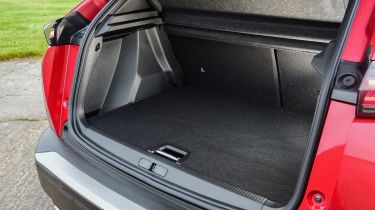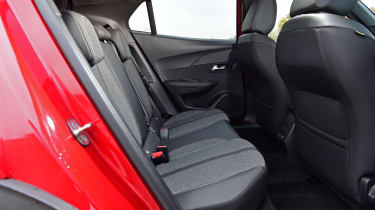Peugeot 2008 - Boot space, comfort & practicality
Some rivals top the Peugeot 2008 for interior and boot space; towing is respectable for the class

|
Dimensions | |
|
Length |
4,300mm |
|
Width |
1,770mm |
|
Height |
1,550mm |
|
Number of seats |
5 |
|
Boot space |
434-1,467 litres |
One of the key downsides to the Peugeot 2008’s styling is that access to the rear is difficult. The sills are high, so you have to climb in over them and, to compound things, you then find the low roofline requires you to stoop in order to get in – rather annoying for anyone strapping children into car seats, for example. Buyers needing frequent access to the rear seats should consider the Hyundai Kona or Skoda Kamiq.
Front and rear parking sensors are standard on every model, while GT trim provides a reversing camera. A 360-degree camera system is available as an option, as is blind spot monitoring to warn you of approaching vehicles along your flanks.
Dimensions and Size
The Peugeot 2008 measures 4,300mm long, 1,770mm wide and 1,550mm tall, making it slightly longer than the Ford Puma (4,207mm), but not quite so wide. The Renault Captur sits between the two, measuring 4,227mm in length.
How practical is the Peugeot 2008?
Seats & space in the front
If you do manage to find a comfortable driving position (as discussed on the previous page), the 2008 has plenty of head, leg, and shoulder room, although visibility isn’t great – making the front and rear parking sensors of mid-range Allure a must. Larger individuals may find that the small steering wheel and tiny pedals can make you feel like a gorilla behind the wheel.
Used - available now
Peugeot hasn’t forgotten basic practicalities, though. There’s still a good level of storage, with cubbies, trays and bins dotted around to hold gadgets and various other items. We particularly like the covered smartphone tray, as it stops you from getting distracted by notifications.
Seats & space in the back
The 2008 doesn’t offer as much room in the back as a Kona or a Kamiq. While it does boast a surprising amount of headroom, legroom isn’t as generous, so it’s not great for ferrying around adults. It’s a shame the 2008 doesn’t feature a sliding rear bench like you get in the Captur, because that would allow rear passengers the option of greater legroom at the expense of some boot space. There’s also a large hump in the floor that eats up rear passenger foot space, so the 2008 is better suited for carrying four people, rather than five.
The 2008 comes as standard with two sets of ISOFIX mounting points – both located on the outer positions of the rear seats.
Boot Space
The Peugeot 2008 offers 434 litres of boot space, which is decent, but beaten by the Kona, which offers 466 litres. Folding the 2008’s rear seats gives you a total of 1,467 litres of boot space to play with. With its 456-litre boot, the Ford Puma also trumps the 2008 and includes a hidden storage compartment called the ‘Megabox’.
The Captur has 12 litres less than the 2008, but as we mentioned, its sliding rear bench seat allows owners to prioritise either boot space or passenger room. Utilise this function by sliding the bench all the way forward, and there are 536 litres on offer, which puts the 2008 at a distinct disadvantage once again.
On a more positive note, all versions come with a variable-height boot floor, which reduces the liftover height and removes the awkward step when the rear seats are folded down.
Towing
All PureTech petrol-powered 2008s have a maximum braked trailer weight of 1,200kg which should be enough to tow a small caravan. The additional weight of the battery, electric motor, and six-speed dual-clutch gearbox of the Hybrid version reduces this version's towing capacity to 1,100kg.
Like many smaller electric vehicles, Peugeot does not quote towing weights for the E-2008.













